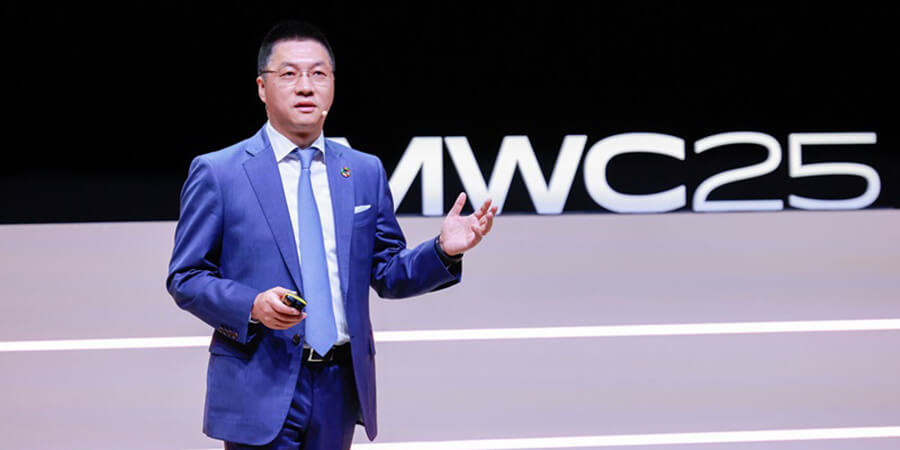Huawei leads the way in pioneering advancements in network capabilities, operational efficiency, and digital infrastructure, shaping the future of the digital landscape. The Chinese technology giant is reinforcing its commitment to driving the mobile AI revolution by accelerating the journey toward an intelligent, artificial intelligence (AI)-driven world.
At Mobile World Congress (MWC) Barcelona 2025, Huawei unveiled new solutions designed to catalyze industries, highlighting the convergence of 5G-Advanced (5G-A) and AI. Huawei emphasized the strategic importance of these solutions in enabling techco transformations and unlocking growth opportunities.
Read: Huawei Launches Innovative Solutions to Drive an Industrial Intelligent Future
Transforming the Mobile AI Revolution
Dang Wenshuan, Huawei’s Chief Strategic Architect, stressed the significance of 5G-A’s role in unlocking new business value in the mobile AI era. This next-generation technology promises to deliver 10 times faster uplink speeds, a 10 dB improvement in signal strength, and a tenfold increase in spectral efficiency, establishing a robust foundation for universal AI accessibility and the seamless integration of intelligent applications.
AI’s impact on network operations is already evident, with improvements in operations and maintenance (O&M) increasing by 30%, energy consumption reducing by 20%, and service assurance rates exceeding 90%. Industry leaders from Ookla, Omdia, and ABI Research confirmed that the growth rate of AI adoption will significantly fuel network data traffic demands.
To support techco transformations, James Chen, President of Huawei Carrier Business, introduced the ‘Five Ones’ capability model, which aims to transform business models, O&M practices, and infrastructure to drive opportunities and create value for carriers. The Five Ones model includes a differentiated experience monetization model, a home AI service entry supporting multimodal interaction, a one-stop cloud platform for business-to-business (B2B) services, a telecom foundation model introducing general AI agents and digital twins, and a synthetic architecture enabling all-element collaboration across networking, storage, cloud, and computing resources.
Moreover, Chen noted that over 35 global carriers have already adopted experience monetization models.
Also Read: Huawei’s Innovative Approach to Redefining Microwave Backhaul in the 5G-A Era
Enabling AI-Centric Solutions
Further accelerating innovation in the mobile AI era, Cao Ming, Vice President of Huawei and President of Huawei Wireless Solution, unveiled AI-centric 5.5G solutions, marking a significant evolution in mobile networks. Spearheading the launch, Ming highlighted, “Mobile AI is booming, bringing three major transformations to mobile networks in terms of user experience (UX), O&M, and business models. Huawei has launched intent-driven, AI-centric 5.5G solutions to help operators seize emerging opportunities by enabling diverse AI application experiences, efficient O&M with high-level network autonomy, and multi-factor business monetization.”
These solutions address three major transformations of AI-centric 5.5G solutions in the mobile industry. Firstly, user experience is evolving from downlink gravitation to diverse dimensions, expanding connections from human-to-human to human-to-AI and AI-to-AI. This transition demands more diverse network capabilities, including higher uplink speeds for multimodal AI interactions, lower latency for real-time agent chats, and ubiquitous AI accessibility.
Secondly, network O&M is advancing from autonomous network (AN) L3 to AN L4 and beyond, driven by AI traffic growth and the complexity of AI connections. Lastly, business models are shifting from traffic-based to multi-factor monetization, with AI application innovations driving operators to focus on experience-based and value-based monetization strategies.
To meet the demands of these challenges, Huawei has developed intent-driven, AI-centric 5.5G solutions to establish a robust connectivity infrastructure in the mobile AI era. Huawei’s GigaGear focuses on efficient resource collaboration across various domains, offering diverse experiences for AI applications. GreenPulse introduces intent-driven automation to maximize spectral and energy efficiency, while GainLeap enables operators to gain experience and value monetization capabilities.
Commenting on the innovations that will drive the intelligent future, Ming stated, “AI-centric 5.5G innovations with three pioneering solutions are just the beginning. Looking ahead, we will continue to innovate alongside all partners to develop more solutions to meet the evolving demands of mobile AI.”
Read More: Huawei: Bridging 5G Excellence and 5.5G Leadership in the AI Era
Innovative Solutions Driving Digital Intelligence
Bruce Xun, President of Huawei Global Technical Service, introduced five groundbreaking ICT services and software solutions to address critical industry challenges, including equipment modernization and cross-domain service continuity for mobile broadband networks. Designed to advance digital intelligence, these innovative solutions integrate cutting-edge technologies, such as the AI Copilot, AI Agent, and Digital Twin Network (DTN), enabling human-machine collaboration while driving business value. By leveraging intelligence, Huawei streamlines carrier operations and delivers superior service quality.
Huawei further emphasized the importance of robust ICT infrastructure in enhancing the digital economy. At the Digital Economy Development Forum, David Wang, Executive Director, Chairman of Huawei’s ICT Infrastructure Managing Board, outlined five strategies to drive digital economy growth and ensure high-quality development while addressing global industry challenges. These strategies include solid digital infrastructure, accelerated digital transformation across industries, future-oriented industry policies, extensive digital talent development, and open, collaborative systems.
Furthermore, Huawei launched tailored innovations for data centers as part of its roadmap to drive an intelligent world. He Bo, President of Huawei Data Center Facility and Critical Power Product Line, unveiled the Single SitePower architecture alongside the RASTM guideline, designed for building next-generation AI data centers. The Single SitePower architecture enables the bidirectional interaction of power and information flows, supporting operators with energy optimization. Meanwhile, the RASTM guideline addresses key challenges faced by modern data centers, such as reliability, agility, and sustainability.
Huawei continues to collaborate with telecom carriers and industry partners to redefine business models, infrastructure quality, and O&M capabilities, for the mobile AI era. By integrating advanced technologies into its solutions, Huawei is paving the way for intelligent networks to adapt and deliver exceptional user experiences. These innovative solutions reflect Huawei’s broader vision to establish a more intelligent and connected world and unlock unprecedented opportunities in the ever-evolving digital landscape.
More on Huawei:
Huawei: Helping CSPs Stay Ahead of the AI Curve
Huawei's Yang Chaobin Highlights AI's Transformative Power at MWC 2025
Huawei Cloud Unveils New Cloud Services and Solutions at MWC 2025
